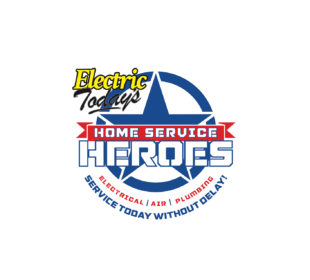For many homeowners, the circuit breaker box is a mysterious object and can seem a bit intimidating. But once you familiarize yourself with its function and understand how it works, it’s actually pretty simple. You should know the basics so that, when needed, you can confidently take control and flip the right switches to restore power to the different areas of your home. The professionals at Home Service Heroes have put together a list of essential notes to help you better understand this essential electrical tool.
What Is A Circuit Breaker Box?
The circuit breaker box is the central distribution point for all of the electrical circuits in your home. Electricity follows a path before it makes its way into your home. First, it flows into your home from the utility company’s lines, and from there it flows through your electric meter (recording the usage). Finally, it flows into the panel of your circuit breaker box which safely redistributes the current throughout your home wiring. In short, think of it as a giant switch that houses smaller switches, which deliver energy to your lights, appliances, and electronics.
Breaker Box Basics: The Parts
Circuit Breaker
The Circuit Breaker Box also houses circuit breakers which are safety devices that cut the power whenever the electrical wiring in your home has too much electrical current running through it. Every circuit in your home has a corresponding breaker. When the power used exceeds the circuit limit, the corresponding breaker will automatically “trip” and shut off the flow of electricity. Common overloads include running too many appliances at once, too many items plugged into a circuit, and a lightning strike.
- Single Pole: Single switches that most likely make up the majority of the breakers in your breaker box. Their capacity is 120 volts and either 15 or 20 amps.
- Double Pole: In what looks like two switches joined together, these have the capacity for 240 volts and are usually between 15-125 amps.
Other types of special breakers include Arc Fault Circuit Interrupters (AFCIs) and Ground Fault Circuit Interrupters (GFCIs) which offer additional safety protection from fire and electrocution.
Service Disconnect
The Service Disconnect is where the power from the electric company flows into the box. It passes through this switch and then flows into the other circuits.
It’s vital to familiarize yourself with the service disconnect and know where to locate it. In case of any emergency, you can turn off the electricity to your entire home by flipping this switch. It’s the largest breaker in the box, and it is sometimes labeled “electrical main.” It is typically found at the top or the bottom of your box, but can also be in the middle.
Expansion Slots
Most breaker boxes come with empty slots, which are needed for the placement of additional circuits you may want to be installed in your home. New circuits must be installed with the addition of a new large appliance or when a new room is added. When you need to add additional circuits to your home, let one of our expert technicians from Home Service Heroes safely handle the installation.
When Should I Replace My Breaker Box?
The average panel in a breaker box can last up to 60 years. But depending on your location, weather can also affect the lifespan of your panel. Some things that can cause issues with your box include circuit breakers being flipped too many times causing damage. If a breaker has gone bad it won’t actually flip, even if there’s too much electricity traveling through the wires, which becomes a hazard to your home. Overloaded circuits will overheat wires, which can break down the insulation and eventually cause a fire. To prevent these kinds of electrical emergencies, we recommend having one of our skilled electricians from Home Service Heroes perform an annual inspection of your circuit breaker box. This will ensure all the breakers are working correctly and give you peace of mind that your home is safe.
Call us at Home Service Heroes to schedule your annual breaker box inspection at (813) 696-3398
